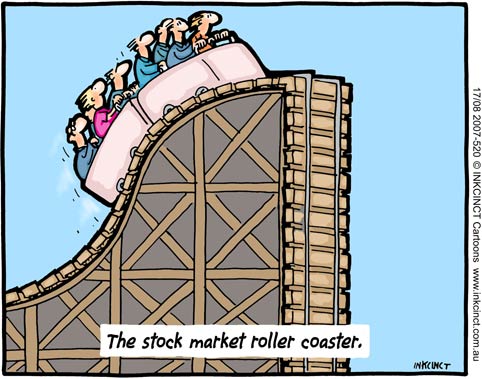
There was a heavy fall in share prices in the Stock Market which resulted into erosion of approx.Rs.4Lakh crores of investors. Though it is not crystallized the effect to that extent due to short fall in the prices. Those who wait and stay in the market and wait for good time can recover in the near future since the economic development is showing growth, in right direction and inflation is under control.
According to me the following are some of the reasons for rise in the share market from 8000 BSE index level to more than 12000 index and steep fall to below 10000 index are as follows :-
- PE Ratio: There was no relation between market price and profitable earnings of the company which is reflected in the form of PE ratio in many cases it was more than economic level of 17. In case of share which quoted more than 17 PE ratio has suffered heavy fall in prices because that was based on speculation rather than profitability of the company.
- Media: Media also projected that BSE index will reach peak level in a very short time which attracted the small investors and resulted heavy loss to them.
- Mutual Funds: Mutual funds also invested heavily when the BSE index was more than 11000 expecting that there will be heavy gains without expecting any correction. The analysis of the mutual funds also in favor boom in the market whereas it was not correct. The mutual funds are dealing with the contributions made by the many small and medium investors. The assured return to the investors has been grossly affected due to fall in prices.The following are the details of losses to Mutual Funds :-
- Worst Losers
- Principal Junior Cap: -35.8
- PruICICI Tax: -35.5
- Tata Tax Saving: -35.3
- StanChart Premier Equity: -35.3
- Taurus Starshare: -35.2
- Kotak Tax Saver: -33.5
- Reliance Tax Saver: -33.2
* Data As On June 8,’06
- Best Performers
- Reliance Equity: -20.3
- UTI Index Select Equity: -21.8
- Sundaram Select Midcap: -21.8
- DBS Chola Contra: -22.8
- Birla Top 100: -25.1
- SBI Bluechip: -25.7
- HDFC Equity: -25.8
- HDFC Top 200: -25.8
(%) – (Source Economic Times,Dt.12.06.2006)
- Worst Losers
- Financial Institutions: Financial Institutions also shown more interest in financing to purchase shares without verifying the share which the investors is going to purchase and what is its PE Ratio and break-even price etc., which resulted into the loss of margin money to the investors and some bad debts in the hands of the Financial Institutions.
- Investors Confidence: Investors confidence was high since the increase in GDP was more than 8% and inflation was under control and continues upward trend in the capital market. The investors also madly invested in acquiring share expecting that the boom will continue since they are not properly educated and equipped with experience and analysis.The extents of loss to share values are as follows:-THE GOOD, THE BAD & THE UGLY
- THE WORST 10 Chg (%)
- Marksans Pharma: -60.2
- ITI: -58.8
- LML: -56.1
- Mahindra Gesco: -56.0
- Hindustan Zinc: -54.8
- HMT: -54.7
- Solectron Centum: -54.4
- Essar Oil: -54.2
- Shaw Wallace & Co: -54.1
- Dwarikesh Sugar:-54.0
- THE WORST 10 Chg (%)
- Sterling Biotech: -15.8
- Kajaria Ceramics: -15.7
- Ruchi Soya: -15.5
- Dredging Corp of India: -14.5
- Mirza International: -11.2
- Astra Microwave: – 8.8
- Centurion Bank of Punjab: – 8.7
- Phoenix Lamps: 1.8
- Adani Exports:7.9The best performers are, Hero Honda and Infosys Tech fell around 16-17%. HDFC and TCS fell around 19%. Wipro, NTPC, Gail, Zee, Satyam and SBI lost around 23%.
Among the big names that suffered a more than 25% fall include Bajaj Auto, Tata Motors, Bhel, ITC, HLL and Reliance Industries, all of whose losses ranged between 25 and 30%. ONGC and Tata Steel fell around 35% or lost a third of their value in less than a month. So, even if you owned absolute blue chips, a fall of at least 20% in the value of your portfolio would match the average rate of fall in the market.
(Source Economic Times, Dt.12.06.2006) - THE WORST 10 Chg (%)
- Foreign Institutional Investors: They are big gainers in the boom and steep fall in the share market since they have entered into the market when the BSE about 9000 and exit at 11000 and more which resulted into heavy selling pressure and steep fall in the prices. They could gain since they are equipped with analysis and expected correction in the market. Also there was no minimum period for institution investors those who invest in the shares of a particular company to hold for any minimum period. The speculation of minimum period of holding would not have resulted into so steep fall.
- Advisers: The role of advisers to invest in shares is very irresponsible and more in favor of speculation rather than in favour of long term investments. Only the long term investments will strengthen the capital market. The short period investment will result only speculation and more turnover low gains to the investors. The role of advisers is very objectionable since they hold no responsibility and safety to market as speculative market rather than as investing market.
- Whistle Blower: There was no body, no organization, no institution acted as Whistle Blower to the small and medium investors who entered into the market at 11000 above BSE index level. Also there was no guidance with regarding the safety; earning and other market speculate terms and conditions to be followed. They are not properly explained of safety precautions of ground level prices shares which are quoting with low PE Ratio high net asset values were not advised, whereas only some specified shares where there was heavy speculation were advised madly to acquire which resulted heavy loss to small and medium investors. If there should have been any Whistle Blower explaining the index PE ratio, net asset value the small and medium investors should not have run madly for shares which are quoted with high PE ratio.
- Regulatory Authority: The regulatory authority should have warned investors for safety to their investment and strength in earning income. Though there is no fear with regarding the administration of activities in the market, payments etc. the precaution part was not properly anticipated by the regulatory authority. The invest not only needs the service of administration and payments but also advisory with regarding the assessment of intrinsic value of a particular Company share. Because the guidelines should have been helpful. Small and medium investors who has lost confidence in the capital market due to steep fall in the prices which resulted into heavy loss to them.
- Investment: At present the investment in capital market is treated as market for speculation and not for long term investment which is the basic purpose of capital market strength. Now the people who are investing are mainly is the dealers and speculators. What ever the people who were acting as investors making investment for long term will leave the market and go for other sort of protected investment which will cause heavy loss to the confidence of the Indian capital market. Infact the investment should be for a minimum period of 10 to 15 years in a company share and also the investors who feel happy in safety and returns in the form of dividend rights and bonus declared by the company from time to time.
- Effect of Exchequer: Many of the mutual funds, investors has invested there savings in the shares as traded in the share market. These organizations and individuals incurred heavy losses which resulted into reduction in there gains and erosion of their capitals which will cause heavy cash crunch, reduction in their incomes thereby reducing the tax collections from them.
On the basis of the above said situation there is a minimum necessity of Authorized Advisory organization which advises the investors for long term investment specifying the parameters of PE ratio, net asset value, return of capital and all other market base analysis. Also the investor should be cautioned where the share price quoting more than that particular industry PE ratio since the price may be fall at any time. Any share price quoting more than industry PE ratio is due to expecting boom and results into speculation which is highly risky for small and medium investors. The game of speculation can be played only by risk bearing institutions and who are having parked funds and accumulated earnings but not for who are entering into the market in a small level, for the long period and for the first time.


